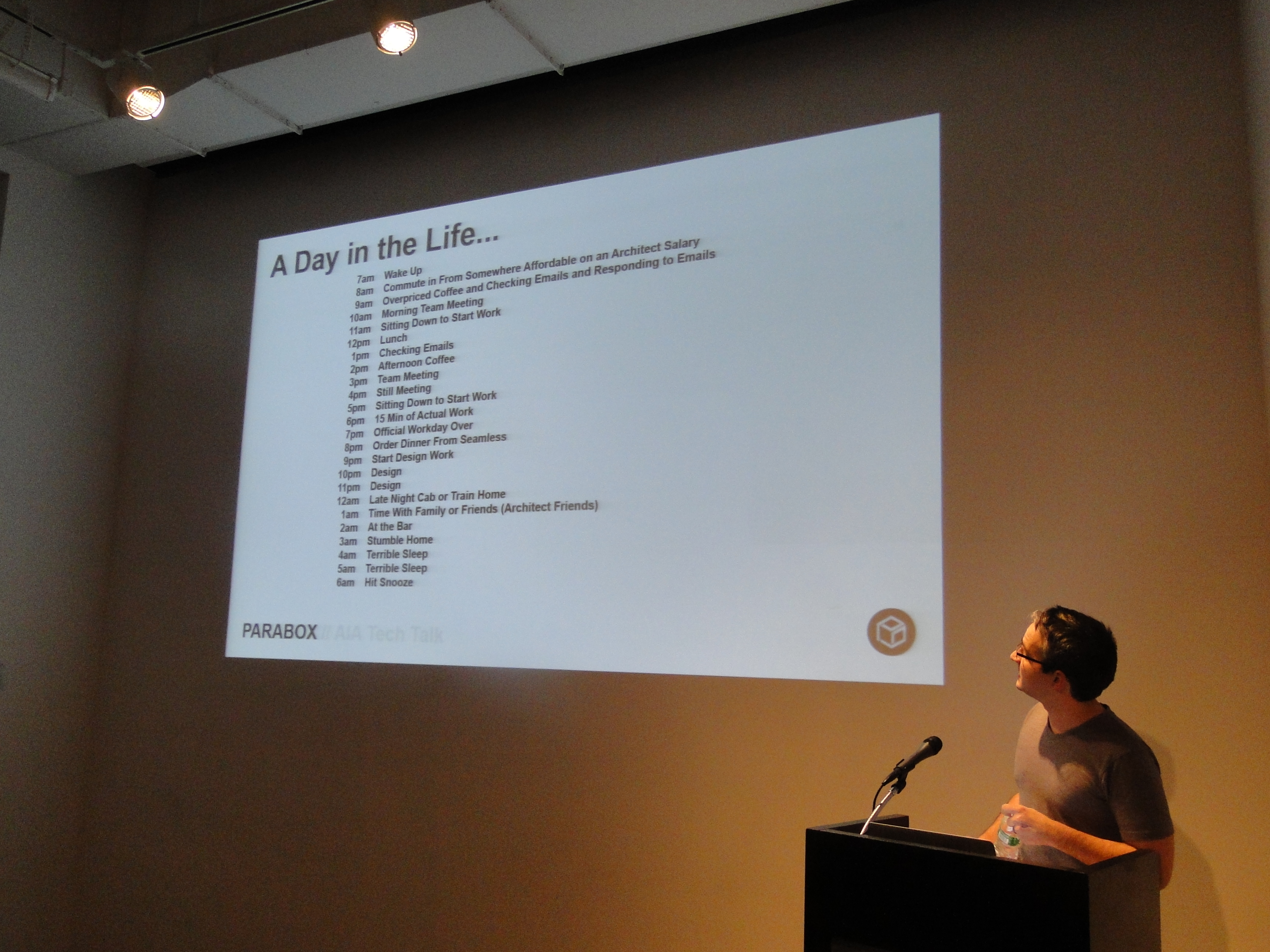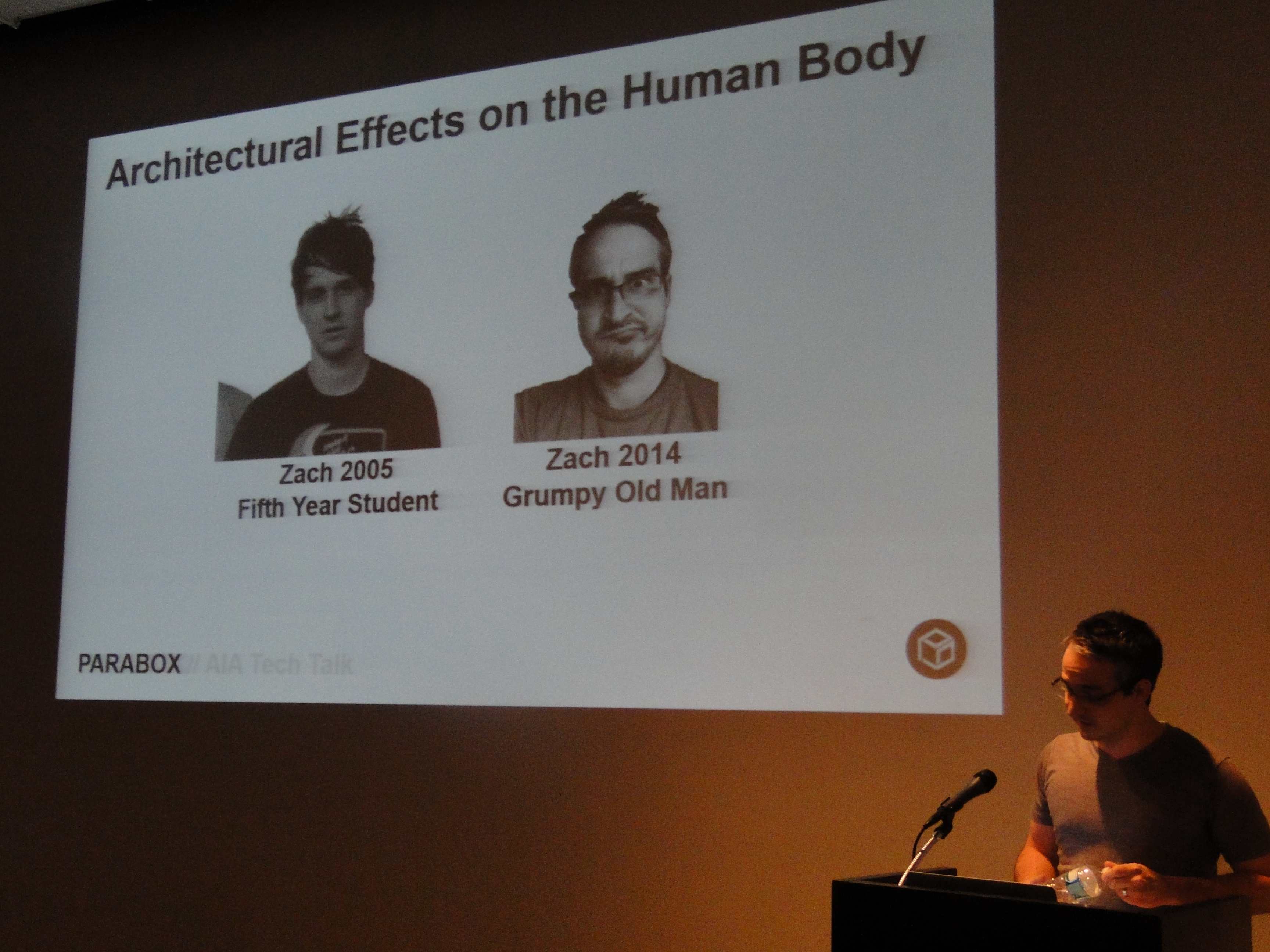by: Melissa Marsh
On 02.11.14, Zach Downey, RA, LEED AP BD+C, co-founder and partner at the NYC-based architectural technology firm Parabox, presented “Automation in Architecture, Design, and IT for Fun and Profit.” The “fun” part could be descriptive of both his sense of humor and gleeful obsession with technology for architecture. Downey focuses on exploiting new technologies for the AEC industry, representing both an emerging set of practitioners who are redefining architecture services and the kind of hybrid design and technology companies expanding in the New York area.
Following a short introduction by Alexandra Pollock, AIA, AIANY Technology Committee leader, Downey began his presentation with a series of humorous critiques of the traditional modes of operation in architectural firms. He used a “day in the life of an architect” to illustrate a situation accepted as normal: the workday is filled with meetings and administration rather than design and invention, until after 5:00 or 6:00PM when the real work might begin and continue on into the late evening. Turning personal, Downey shared photos and videos of his twin baby girls – effectively expressing a very good reason for wanting to get the real work done in daylight hours and find time for the other fun things in life – family.
Following this exploration of “time mis-management” and a critique of the backwards personnel practices at many architecture firms, Downey went on to present a series of mini-case studies which represented the wide range of applications for automation in architecture. These automation sequences demonstrate solutions to a variety of workplace, work process, drawing, and analytical issues. Downey and his team have been working with a number of traditional and emerging architectural offices to automate processes within individual and across multiple projects. Some of the more well-known approaches include project examples using Grasshopper, Rhino, and a variety of data bases to analyze and visualize potential design solutions. These explorations then inform architectural design, simplify form making, or optimize building performance.
Parabox examples also included automating drawing and visualization setup, and presentation assembly “busy work,” =such as composing multiple views, or the same perspective of many iterations for presentation boards, or automating the setup of various drawing standards.
Under the ironic heading of “asset management,” Downy described the more unconventional approach of using location data, Four-Square, and other social check-in data to track team members’ time. These data assembled by Parabox colleagues on the go could then be aggregated into a single spreadsheet – an online database – for quick and easy timesheets and client billing.
As I watched a video of the event on my smartphone while sitting in a hotel room in San Jose, CA – hardly a stone’s throw from the likes of LinkedIn, Twitter, Apple, Google – I thought that we architects might finally have stepped into the 21st century. On the other hand, is this something that we still see as an anomaly rather than the imminent future?
Thinking of large and small offices around the country, I still believe that there is a long way to go. As Downey’s title declares, the purpose of these automations is for “Fun and Profit”; yet industry-wide we may not be effectively leveraging the profit component. The type of work that Downey and his team do is often hidden in the technology and CAD teams of an architecture firm, unrecognized or under recognized. Until these talents leave the larger firm, as Downey did, and then charge for such services on their own.
In a short conversation with Downey after the event, we discussed issues of compensation for individuals who are innovating within the context of their architecture firms – architects who are hacking on both CAD and business practices by coding new solutions to old problems. We also spoke of the potential for industry improvement through greater community sharing of solutions and code. I remember when, in the late 1990s (we still had monitors deeper than they were wide), a colleague wrote a macro to fill any polygon with the squiggly line that represented insulation. He practically danced around the office, then sat down and sent a link to the server location to everyone in the office. This combination of recognizing recurring problems, inventing solutions, and sharing the results is the basis of the “fun” that Downey describes – and sharing is part of that fun.
As he mentioned during the presentation, Downey and team have begun sharing some of their solutions at www.paraboxlabs.com – so get in there, contribute, hack, and give back.
Melissa Marsh is Founder and CEO of Plastarc, a social research, workplace innovation, and real estate strategy firm serving tenants, owner-occupiers, often in collaboration with architecture and design firms. Plastarc is a portmanteau of Plastic and Architecture representing a focus on making architecture more flexible, dynamic, and fun,= through social research and analytics. Melissa is a regular contributor to e-Oculus, and can be reached at melissa@plastarc.com.
Event: Automation in Architecture, Design and IT for Fun and Profit
Location: Center for Architecture, 02.11. 14
Speakers: Zach Downey, RA, LEED AP BD+C, Partner and Cofounder, Parabox, and Alexandra Pollock, Director of Design Technology, FXFOWLE and leader of the AIANY Technology Committee
Organizers: AIANY Technology Committee
Sponsored by: ABC Imaging










